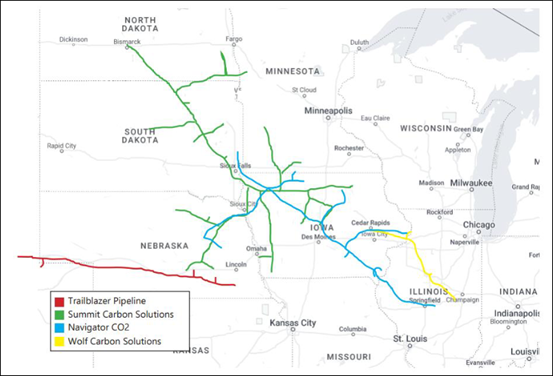posted by Spencer Parkinson on Monday, May 8, 2023
As we continue to unceasingly march toward the halfway mark of 2023, I thought an update on the exciting work the DIS Team has been engaged in would be appropriate. And, while I may be a bit biased in my assessment that we have an outsized corner on talent here at DIS, we just may be singing out of the same hymnal before you’re done reading and exploring this update. Read on:
Renewable Fuels Policy
The Inflation Reduction Act has spawned several projects for us in the last year, many of which are focused on the 45Z tax credit and soybean crushing capacity. A few examples include:
- We recently completed and published the results from two projects (later combined into one report) for the Iowa Renewable Fuels Association, found here. This analysis studied the impact of a carbon pipeline not being permitted to cross Iowa, both in terms of economic impact on the industry itself (and therefore on Iowa) and in terms of the price Iowa farmers receive (i.e., basis) for corn grown on their farms. Below is a map showing proposed carbon pipelines.

-
We completed a project for a Nebraska client, which dealt with the projected growth in soybean meal production due to projected increases in demand for soybean oil used in renewable fuels. Using our Dynamic Commodity Flow methodology, this project modeled the change in movement of soybeans from points of production (i.e., the farm) to points of delivery (i.e., crush or export).
Livestock and Poultry Rations
Across the Midwest, soybean crush could expand by more than 775 million bushels resulting in a 35% increase in soybean meal supplies. Expanding domestic consumption of soybean meal by livestock and poultry is critical to maintaining value for soybeans produced in the United States. To this end, the DIS Team has completed, or is in the midst of completing, the following work:
- Using our “Ration Cost Optimization” methodology to study major livestock and poultry species’ ration dynamics, we worked through a series of scenarios that estimated the amount of soybean meal that could be consumed if one or both of the following situations to handle additional supplies of soybean meal were pursued: 1) animal inventories and production increased; and 2) inclusion rates of soybean meal were maximized.
- A new soybean crush plant has been proposed in Iowa. We answered the following questions:
- How would this new plant affect the flow of soybeans?
- What would the economic impact of this new plant be in terms of jobs, dollars, taxes, etc. to the local area?
- What impact would the new plant have on the price farmers receive for their soybeans?
Economic Impact Studies
Estimating the impact of a change in an economy (an economic impact study) and the current contribution of a business, industry or set of industries (an economic contribution study) to the local economy has long been a significant portion of our work. A few recent examples include:
- Estimating the economic impact of a new lake being proposed in Iowa. This analysis includes estimating the construction of the dam and associated homes and supporting businesses, the ongoing operations of businesses which grow or enter the area because of the lake, the demand and associated impact of providing local utilities, and how demographics may be impacted by the new lake. We also estimated the impact of the most likely public financing option to be pursued by the city.
- Estimating the economic contribution of an agricultural multi-location private companies in the United States and how individual locations support local economies (i.e., at the county level) individually and collectively (all locations in all states).
- A forthcoming study for the American Feed Industry Association, which updates earlier work that estimated the economic contribution of the nation’s feed production and milling industries for all 435 congressional districts, 50 states and the United States.
- Estimating the impact of a livestock market in Missouri. In short, we found, for the average livestock market, that $2 million in total value-added dollars are added to the local communities where livestock auctions are located. Results can be found here.
The above examples are just a fraction of the exciting work we’ve been knee-deep in over the last few months. With as much variety as we have in our work and the “can do” attitude of each member of the Team, the rest of 2023 looks to be an exciting one. We are eager to continue interacting with current and past clients and are excited to venture into new territory with completely new clients.
With warmest regards,
Spence Parkinson